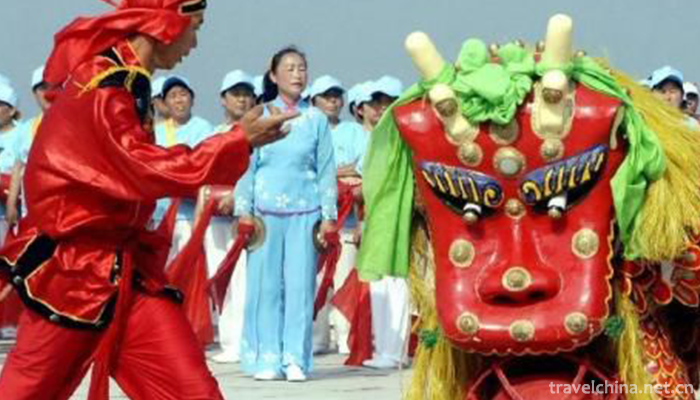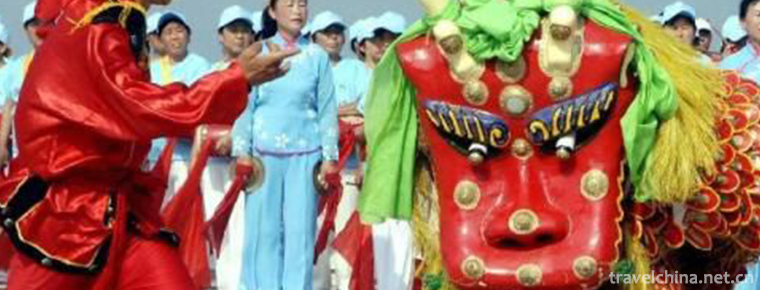kylin dance
kylin dance
Kirin dance, also known as "Wu" Kirin, is a court dance performance of the Ming Dynasty in China. It was spread among the people when the Nanming Dynasty perished. When dancing, one person dances Kylin Head and one person dances Kylin Tail, and two people cooperate with each other tacitly, so as to vividly express the joy, anger, sadness, joy, surprise, suspicion, drunkenness and sleep of the legendary Kylin. On New Year's Day, people dance Kirin to express their good wishes of welcoming good fortune and praying for good weather and national peace.
Kirin is a kind of animal representing auspiciousness in ancient Chinese legends. It is called "Four Spirits" together with phoenix, turtle and dragon. It ranks first among the "Four Spirits". There is the saying of exorcising evil spirits and avoiding ghosts among the people. People of all dynasties regard it as a symbol of auspiciousness. The image of Kirin has a history of more than 2500 years in China. For a nation, it has developed from a totem, a belief to a philosophical significance, and then into the literary field, finally to plastic arts and performing arts. This shows that Kirin has evolved from a "myth and legend" to a "cultural phenomenon". Kirin dance, as a carrier of Kirin culture and a rare kind of dance, is still active in the folk. The "Daliuzhai Kirin Dance" in Liudi Town, Suxian County, Henan Province is its typical representative. Guangdong Province is a region where Kirin dance is widely spread.
Kirin dance, which integrates music, dance, arts and crafts and acrobatics, has not only aesthetic appreciation value, but also literary, religious, folk and historical research value, which is a precious property left by our ancestors to the descendants of China.
On June 7, 2008, the Qilin Dance declared by Lankao, Huanghua and Haifeng was listed in the second batch of national intangible cultural heritage list by the State Council.
In May 2011, the "Kirin Dance" declared by Suxian, Houma, Shenzhen and Dongguan was included in the second batch of national intangible cultural heritage "Kirin Dance" projects by the State Council in the form of an expanded project list.
Historical Evolution
According to historical records such as Daming Unified Chronicle, Qixian Chronicle and Feng Family Genealogy, "Qi County Chronicle"
Lindan Dance, originally only a performing art in the palace, is called "Qilin Holy Dance", which is a necessary performance in various royal celebrations. When the Nanming Dynasty perished (1661 A.D.), Wenlin Lang Feng Weigui, who was in charge of palace culture and entertainment, returned to Lixian County, Henan Province. He brought a pair of "Kirin Peels" to the Feng people in Daliuzhai Village, Suxian County, and personally taught the skills of dancing. Kirin dance originated from the Feng family has passed on for 15 generations and has gone through more than 35 years of history. In the late Ming Dynasty, "Qilin Dance" flowed into the folk of Lixian County from the imperial court. As the Royal dance inherited by the Feng family form, it basically retained the dance style and original form of the Ming Dynasty more than 300 years ago. The teacher-inheritance relationship of Qilin Dance is special. The conditions for selecting performers are quite strict, forming performance groups, continuing from generation to generation, and emphasizing that the skills learned are not allowed to be passed on.
The Qilin Dance in Guangdong Province witnesses the migration of Hakkas from the north to the south. It is accompanied by gongs, drums and suonas. It has a typical style of Flower Fairs in the Central Plains, which is different from Lingnan music in Guangdong Province.
Similarly, it is the art and culture handed down from generation to generation by the Hakka people.
In February 2007, Kirin Dance in Suxian County was listed as the intangible cultural heritage of Henan Province.
On June 7, 2008, the Qilin Dance declared by Lankao County, Huanghua City and Haifeng County was included in the second batch of national intangible cultural heritage list by the State Council.
In May 2011, Kirin Dance declared by Suxian, Houma, Shenzhen and Dongguan was included in the second batch of national intangible cultural heritage items by the State Council in the form of an expanded project list.


-
1.Chess cake
Chess cake is a special product of Tangshan District in Hebei Province. It is named for its shape like a small drum and a chess piece
Time 2018-11-27 -
2.Xiangsha Bay Scenic Spot in Dalat Banner Ordos
Xiangsha Bay was opened as a tourist attraction in January 1984, listed as a national line scenic spot by the National Tourism Administration in 1991
Time 2018-11-29 -
3.Chaohu Lake Scenic Area
Located in the middle of Anhui Province, Chaohu Lake is located in Hefei, Lianhuai Tongjiang River, 55 kilometers east-west, 22 kilometers South-North wide. Its perennial water area is about 760 squar
Time 2019-01-05 -
4.Shuimogou Scenic Area
Shuimogou Scenic Area, also known as Shuimogou Park, is named after Shuimogou in the scenic area. It is located in the eastern suburb of Urumqi, Xinjiang. Around 2000
Time 2019-02-13 -
5.Rice custom
Wannian rice custom and Shangrao Wannian County custom are cultural heritage. Wannian is the "land of rice". The traditional rice custom has been passed down in this area for thousands of ye
Time 2019-04-26 -
6.Flower Drum Opera
Huagu opera, a kind of local opera in China, has the most identical names in the national local opera, usually referring to Hunan Huagu opera. Hubei, Anhui, Jiangxi, Henan, Shaanxi and other
Time 2019-05-04 -
7.Grey plastic
Gray plastic gray plastic, known as gray batch in ancient times, is the traditional architectural decoration technology in Lingnan area. The material is mainly lime.
Time 2019-05-04 -
8.Leting drum
Music Pavilion Drum is a representative form of traditional music drum book and drum music in northern China. It is widely spread in eastern Hebei, Beijing, Tianjin and northeastern Liaoning, Jilin, H
Time 2019-05-11 -
9.Wood Engraving Picture
In Chinese folklore, New Year's pictures are the symbol of the New Year. If they are not pasted, they will not be counted as the New Year's Day. New Year pictures are not only decorations for festival
Time 2019-06-05 -
10.Quyang stone carving
Quyang stone carving is an important part of folk art in Quyang County, Hebei Province. Since the Western Han Dynasty, Quyang stone workers have used marble to carve steles and other objects. Quyang s
Time 2019-06-11 -
11.Longtan Karst Cave Scenic Spot
Longtan Karst Cave Scenic Area is located at the foot of longcuban mountain, Miyi Baima Town, Panzhihua City, Sichuan Province, with an altitude of 1500 meters. It is a provincial-level scenic spot and a national AA level tourist area.
Time 2020-10-15 -
12.Huanglian earth forest
Huanglian earth forest, namely the earth forest in huanglianguan Town, is a geomorphic landscape developed on a set of ice water freeze-thaw debris flow deposits. Huanglian earth forest is located in huanglianguan Town
Time 2020-10-16